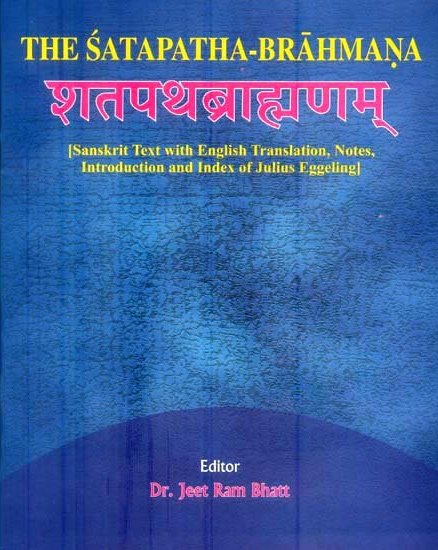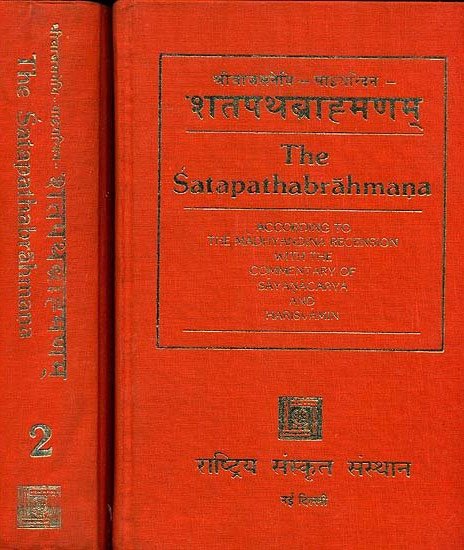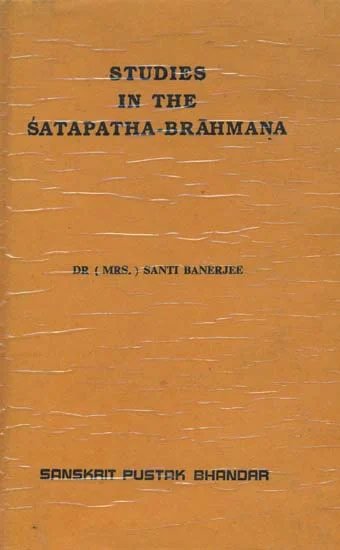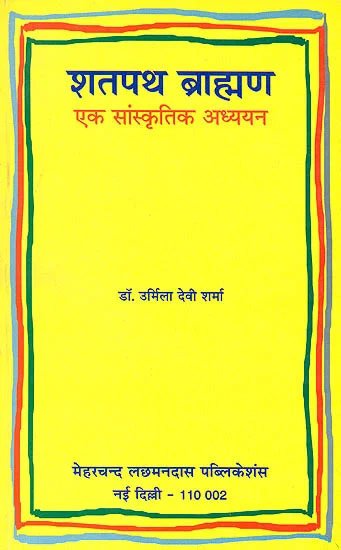Satapatha-brahmana [sanskrit]
147,532 words | ISBN-10: 812080113X | ISBN-13: 9788120801134
The Sanskrit text of the Satapatha-brahmana: One of the largest works in the category of Vedic (Brahmaic) literature, narrating in extensive detail the various rites, constructions, chants and utensils to be used in Hindu ceremonies. Alternative titles: Śatapathabrāhmaṇa (शतपथब्राह्मण), Śatapatha-brāhmaṇa (शतपथ-ब्राह्मण) Shatapathabrahma (shatapatha).
Verse 5.3.1.10
atha śvo bhūte | akṣāvāpasya ca gṛhebhyo govikartasya ca gavedhukāḥ sambhṛtya sūyamānasya gṛhe raudraṃ gāvedhukh!ṃ caruṃ nirvapati te vā ete dve satī ratne ekaṃ karoti sampadaḥ kāmāya tadyadetena yajate yāṃ vā imāṃ sabhāyāṃ ghnanti rudro haitāmabhimanyate'gnirvai rudro'dhidevanaṃ vā agnistasyaite'ṅgārā yadakṣāstamevaitena prīṇāti tasya ha vā eṣānumatā gṛheṣu hanyate yo vā rājasūyena yajate yo vaitadevaṃ vedaitadvā asyaikaṃ ratnaṃ yadakṣāvāpaśca govikartaśca tābhyāmevaitena sūyate tau svāvanapakramiṇau kurute tasya dvirūpo gaurdakṣiṇā śitibāhurvā śitivālo vāsirnakharo vāladāmnākṣāvapanam prabaddhametadu hi tayorbhavati
Preview of English translation:
10. And on the following day, having brought together gavedhuka (seeds) from the houses of the Keeper of the dice (akshavapa) and the Huntsman (govikartana), he prepares a gavedhuka pap for Rudra at the house of him who is consecrated. These two, while being two jewels (of the king), he makes one for the purpose of completeness. And as to why he performs this offering,—Rudra is hankering after that (cow) which is killed here in this hall; now Rudra is Agni (fire), and the gaming-board being fire, and the dice being its coals, it is him (Rudra) he thereby pleases. And verily whosoever, that knows this thus, performs the Rajasuya, in his house that approved (cow) is killed. And he, the keeper of dice, and the huntsman, are (each of them) assuredly one of his (the king's) jewels: it is for these two that he is thereby consecrated, and these two he makes his own faithful followers. The sacrificial fee for this (jewel) is a bicoloured bullock—either one with white fore-feet, or a white-tailed one,—a claw-shaped knife, and a dice-board with a horsehair band; for that is what belongs to those two.
For a detailled translation, including proper diacritics and footnotes, go the full English translation.
Other editions:
Also see the following editions of the Sanskrit text or (alternative) English translations of the Satapatha-brahmana Verse 5.3.1.10
The Satapatha Brahmana (In Five Volumes)
by Julius Eggeling (1882)
2551 pages; [Publisher: Motilal Banarsidass Publishers Pvt. Ltd.]
Buy now!
The Satapatha Brahmana (3 volumes)
by Dr Jeet Ram Bhatt (2009)
Sanskrit Text with English Translation; 1726 pages; [Publisher: Eastern Book Linkers]; ISBN: 9788178541693
Buy now!
The Satapatha Brahmana (With The Commentary of Sayanacarya and Harisvamin)
by Rashtriya Sanskrit Sansthan (2002)
3483 pages; [शतपथ ब्राह्मणम्] According to the Madhyandina Recension; Commetaries: (1) Vedarthaprakash (Vedartha-prakasha) by Shrimat-Trayibhashyakar Sayanacharya, (2) Sarvavidyanidhana Kavindracharya Saraswati.
Buy now!
Studies in the Satapatha-Brahmana
by Dr. (Mrs.) Santi Banerjee (1993)
236 pages; [Publisher: Sanskrit Pustak Bhandar]
Buy now!
Cultural Study of the Satapatha Brahman (in Hindi)
by Dr. Urmila Devi Sharma (1982)
106 pages; Shatapatha Brahmana Ek Sanskritik Adhyan; [Publisher: Meharchand Lakshmandas Publications]
Buy now!![Satapatha-brahmana [sanskrit] - book cover](/uploads/a/NAC457-Satapatha-Brahmana.jpg)



